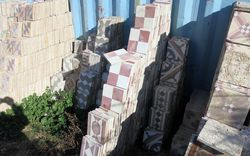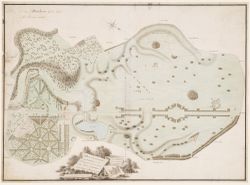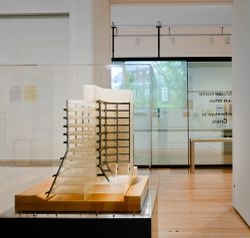textual records
AP197.S1.SS9.015
Description:
The box contains drafts, final copies, correspondence and notes for various articles, book projects, interviews, keynote addresses, and lectures by Kenneth Frampton. The materials are organized in alphabetical order, from I-K. The largest portion of this box consists of: drafts and transcripts of interviews with Kenneth Frampton; drafts, articles, correspondence and research materials for an unpublished book project on Japanese Building Practices/Japanese Contemporary Architecture; correspondence and drafts for the Jerusalem Seminar in Architecture; and correspondence and notes for a Panos Koulermos book project. Other subjects and architects explored in these texts include Arata Isozaki, Kritsin Jaramund, Michael Kagan, Louis Kahn, Rem Koolhaas, Kengo Kuma, and Kisho Kurakawa.
1985-2016
Kenneth Frampton writings (I-K)
Actions:
AP197.S1.SS9.015
Description:
The box contains drafts, final copies, correspondence and notes for various articles, book projects, interviews, keynote addresses, and lectures by Kenneth Frampton. The materials are organized in alphabetical order, from I-K. The largest portion of this box consists of: drafts and transcripts of interviews with Kenneth Frampton; drafts, articles, correspondence and research materials for an unpublished book project on Japanese Building Practices/Japanese Contemporary Architecture; correspondence and drafts for the Jerusalem Seminar in Architecture; and correspondence and notes for a Panos Koulermos book project. Other subjects and architects explored in these texts include Arata Isozaki, Kritsin Jaramund, Michael Kagan, Louis Kahn, Rem Koolhaas, Kengo Kuma, and Kisho Kurakawa.
textual records
1985-2016
archives
Level of archival description:
Fonds
John C. Parkin fonds
AP018
Synopsis:
The John C. Parkin fonds documents the professional career of Toronto-based architect John C. Parkin (1922-1988) at his firms John B. Parkin Associates and Parkin Architects Planners. Most materials in this fonds record 347 architectural projects covering the years 1947-1987. John C. Parkin’s professional involvement in the arts and architecture, his firms’ activities, and his professional achievements are also recorded.
1929-1987
John C. Parkin fonds
Actions:
AP018
Synopsis:
The John C. Parkin fonds documents the professional career of Toronto-based architect John C. Parkin (1922-1988) at his firms John B. Parkin Associates and Parkin Architects Planners. Most materials in this fonds record 347 architectural projects covering the years 1947-1987. John C. Parkin’s professional involvement in the arts and architecture, his firms’ activities, and his professional achievements are also recorded.
archives
Level of archival description:
Fonds
1929-1987
archives
Level of archival description:
Fonds
Umberto Riva fonds
AP180
Synopsis:
The Umberto Riva fonds documents Riva’s work as an architect and designer, predominantly in Italy, between the 1960s to the early 2010s. Included are drawings related to over 80 architectural projects, furniture designs, and exhibition designs.
1959-2012
Umberto Riva fonds
Actions:
AP180
Synopsis:
The Umberto Riva fonds documents Riva’s work as an architect and designer, predominantly in Italy, between the 1960s to the early 2010s. Included are drawings related to over 80 architectural projects, furniture designs, and exhibition designs.
archives
Level of archival description:
Fonds
1959-2012
archives
Level of archival description:
Fonds
Douglas C. Simpson fonds
AP076
Synopsis:
The Douglas C. Simpson fonds documents Simpson's 1938 graduation thesis project, residential projects from early in his career in Ottawa, furniture projects, and residential and commercial projects in British Columbia including those by the firm Semmens, Simpson. The fonds is composed primarily of drawings and photographs dating from 1938-1992, with the bulk of the documents ranging from ca. 1940 to ca. 1960.
1938-1992, [predominant ca. 1940-ca. 1960]
Douglas C. Simpson fonds
Actions:
AP076
Synopsis:
The Douglas C. Simpson fonds documents Simpson's 1938 graduation thesis project, residential projects from early in his career in Ottawa, furniture projects, and residential and commercial projects in British Columbia including those by the firm Semmens, Simpson. The fonds is composed primarily of drawings and photographs dating from 1938-1992, with the bulk of the documents ranging from ca. 1940 to ca. 1960.
archives
Level of archival description:
Fonds
1938-1992, [predominant ca. 1940-ca. 1960]
archives
Level of archival description:
Fonds
Barry Downs fonds
AP077
Synopsis:
The Barry Downs fonds contains 6 drawings and 8 presentation panels for a total of 11 projects conceived between 1956 and 1968. This period coincided with Down's position as design architect for Thompson, Berwick, Pratt & Partners, and his subsequent partnership with Fred Thornton Hollingsworth. The documents, particularly the drawings, reveal the considerable skill Downs possessed as both a draughtsman and a designer.
[1956-1968]
Barry Downs fonds
Actions:
AP077
Synopsis:
The Barry Downs fonds contains 6 drawings and 8 presentation panels for a total of 11 projects conceived between 1956 and 1968. This period coincided with Down's position as design architect for Thompson, Berwick, Pratt & Partners, and his subsequent partnership with Fred Thornton Hollingsworth. The documents, particularly the drawings, reveal the considerable skill Downs possessed as both a draughtsman and a designer.
archives
Level of archival description:
Fonds
[1956-1968]
archives
Level of archival description:
Fonds
AP128
Synopsis:
The Harold Ship Alexis Nihon Plaza and Nuns’ Island Master Plan project records, (1956- 1973), document architect Harold Ship’s design and plan for the Alexis Nihon Plaza (1956-1965) and the Nun’s Island Master Plan (1959-1973). Materials in these project records consist of 1 619 drawings (including reprographic copies), 330 photographs, 5 l.m. of textual records, 5 models and 2 panels.
1956-1973
Harold Ship Alexis Nihon Plaza and Nuns’ Island Master Plan project records
Actions:
AP128
Synopsis:
The Harold Ship Alexis Nihon Plaza and Nuns’ Island Master Plan project records, (1956- 1973), document architect Harold Ship’s design and plan for the Alexis Nihon Plaza (1956-1965) and the Nun’s Island Master Plan (1959-1973). Materials in these project records consist of 1 619 drawings (including reprographic copies), 330 photographs, 5 l.m. of textual records, 5 models and 2 panels.
archives
Level of archival description:
Fonds
1956-1973
articles
Into the material world
archives
Level of archival description:
Fonds
Chuck Hoberman fonds
AP165
Synopsis:
The Chuck Hoberman fonds documents Hoberman’s work in transformable design throughout the first part of his career, from 1980 to 2006, as well as the operations of his company Hoberman Associates Inc. Materials relate to the research and development of design concepts, the patenting of inventions, detailed drawings for certain unfolding structures, the workings and movements of mechanisms, public presentations at fairs and exhibitions, and media coverage.
circa 1980-2006
Chuck Hoberman fonds
Actions:
AP165
Synopsis:
The Chuck Hoberman fonds documents Hoberman’s work in transformable design throughout the first part of his career, from 1980 to 2006, as well as the operations of his company Hoberman Associates Inc. Materials relate to the research and development of design concepts, the patenting of inventions, detailed drawings for certain unfolding structures, the workings and movements of mechanisms, public presentations at fairs and exhibitions, and media coverage.
archives
Level of archival description:
Fonds
circa 1980-2006
British gardens and garden buildings have held particular importance in British artistic and cultural life over the last four centuries, as well as influenced the development of the architectural and landscape ideas of the European and North American continents. An English Arcadia 1600–1990 documents the history of these gardens and buildings. The exhibition consists of(...)
Main galleries
12 February 1992 to 19 April 1992
An English Arcadia, 1600-1990: Designs for Gardens and Garden Buildings in the Care of the National Trust with Selected Objects from the CCA Collections
Actions:
Description:
British gardens and garden buildings have held particular importance in British artistic and cultural life over the last four centuries, as well as influenced the development of the architectural and landscape ideas of the European and North American continents. An English Arcadia 1600–1990 documents the history of these gardens and buildings. The exhibition consists of(...)
Main galleries
Architect James Frazer Stirling’s work has resisted characterization because of its radical shifts in influence, named by others as prewar modernism to Neoclassicism, Rationalism and Brutalism to Postmodernism. But the continuity of his thinking emerges through the quantity and variety of material in the James Stirling/Michael Wilford Archive, a tool for understanding an(...)
Main galleries
16 May 2012 to 14 October 2012
Notes from the Archive: James Frazer Stirling
Actions:
Description:
Architect James Frazer Stirling’s work has resisted characterization because of its radical shifts in influence, named by others as prewar modernism to Neoclassicism, Rationalism and Brutalism to Postmodernism. But the continuity of his thinking emerges through the quantity and variety of material in the James Stirling/Michael Wilford Archive, a tool for understanding an(...)
Main galleries


